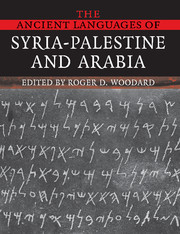Book contents
- Frontmatter
- Contents
- List of figures
- List of tables
- List of maps
- List of contributors
- Notes on numbering and cross-referencing
- List of abbreviations
- Preface
- Preface to the first edition
- Map
- 1 Language in ancient Syria-Palestine and Arabia: an introduction
- 2 Ugaritic
- 3 Hebrew
- 4 Phoenician and Punic
- 5 Canaanite dialects
- 6 Aramaic
- 7 Ancient South Arabian
- 8 Ancient North Arabian
- Appendix 1 Afro-Asiatic
- Appendix 2 Full tables of contents from The Cambridge Encyclopedia of the World's Ancient Languages, and from the other volumes in the paperback series
- Index of general subjects
- Index of grammar and linguistics
- Index of languages
- Index of named linguistic laws and principles
7 - Ancient South Arabian
Published online by Cambridge University Press: 22 September 2009
- Frontmatter
- Contents
- List of figures
- List of tables
- List of maps
- List of contributors
- Notes on numbering and cross-referencing
- List of abbreviations
- Preface
- Preface to the first edition
- Map
- 1 Language in ancient Syria-Palestine and Arabia: an introduction
- 2 Ugaritic
- 3 Hebrew
- 4 Phoenician and Punic
- 5 Canaanite dialects
- 6 Aramaic
- 7 Ancient South Arabian
- 8 Ancient North Arabian
- Appendix 1 Afro-Asiatic
- Appendix 2 Full tables of contents from The Cambridge Encyclopedia of the World's Ancient Languages, and from the other volumes in the paperback series
- Index of general subjects
- Index of grammar and linguistics
- Index of languages
- Index of named linguistic laws and principles
Summary
HISTORICAL AND CULTURAL CONTEXTS
Ancient (or Epigraphic) South Arabian (for terminology see Macdonald 2000:30), which is considered part of the southern branch of the Semitic language family, is divided into four main dialects, Sabaic, Minaic, Qatabanic, and Hadramitic, which are named after the most important peoples of southwest Arabia in the first millennium BC. These peoples founded their towns at the eastern edges of the central Yemeni highlands, in the wadi deltas that lead into Ramlat as-Sab‘atayn, the desert edge of the Rub‘al-ḫālī, where favorable natural and geographical conditions prevail. Since Ramlat as-Sab‘atayn is also called Ṣayhad by the medieval Yemenite geographers, the term Ṣayhadic, coined by A. F. L. Beeston, has also been used in Sabaic scholarship recently as a generic term for the Ancient South Arabian dialects.
The dialect attested for the longest period and by the most inscriptions by far is Sabaic, the core area of which comprises the region of Mārib and Ṣirwāḥ, but which later also extended to a large part of the highland.
The first Sabaic inscriptions begin in the eighth century BC; the first Sabaic monuments of any length that can be dated reliably by a synchronism with Assyrian sources are to be placed in the early seventh century BC (Wissmann 1982:148).
- Type
- Chapter
- Information
- The Ancient Languages of Syria-Palestine and Arabia , pp. 145 - 178Publisher: Cambridge University PressPrint publication year: 2008
- 3
- Cited by

